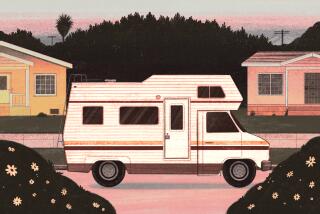Recreational Vehicle Industry Is Humming Along Road to Growth
- Share via
Pete Recchio was just completing the funding and incorporation of his new recreational vehicle company last year when the terrorist attacks hit New York and Washington, bringing car sales and leisure travel to a screeching halt.
Shaken personally by the tragedy, he also was alarmed that his fledgling business would be stillborn, opening at a time when Americans were shunning big-ticket purchases, such as motor homes and trailers, and shying away from traveling for pleasure.
Fleetwood Enterprises of Riverside, the country’s largest RV maker, shared that apprehension.
“Initially, orders were severely depressed, and we were quite concerned because we had seen some recovery after the big Nasdaq decline of March 2000,” said Fleetwood Treasurer Lyle Larkin.
Claude Donati, vice president of sales and marketing for Gulfstream Coach Inc., is more blunt about his distress.
“We all thought the show was going down the toilet,” he said, referring to the RV market.
They needn’t have worried. The $9-billion RV industry, which runs from $5,000 trailers to million-dollar-plus motor homes, is booming. Sales are up 17% through August over the first eight months of last year. Stock prices have shot up for RV makers, which are boosting production. Margins are healthy.
And it’s not so much despite Sept. 11 but because of it.
“It proves to us many times that the RV lifestyle is a passion and a goal of many people,” said Recchio, sitting in a comfy swivel chair in the back of one of the 29-foot trailers made by his company, Ameri-Camp of Syracuse, Ind.
“It’s a time when we can get away as a family and interact as a family, expose the kids to other parts of the country,” said Amy Emett of Monrovia, who has been “RV’ing” ever since she got married 19 years ago and hopes to lease their house and retire with her husband to their 38-foot motor home within 15 years.
Life at home is busy with both parents working and two teenage girls busy with school, friends and sports. But the dozen or more trips a year the the Emetts take in their Winnebago Adventurer give them the chance to catch up with one another, as well as others who share their RV ardor.
“I absolutely love everyone we meet,” said Emett, 40.
Daughter Bethanie is just as fervent: “It’s the best,” the 15-year-old said, especially the family trips to Rancho Oso in the Santa Barbara Mountains, where the family has made lifelong friends.
These days her elder sister, Sherr, 18, is outgrowing the family travel bug and stays inside the motor home more.
“As long as she has a TV and a mirror, she’s OK,” Bethanie said. “Me, I like traveling with the family.” Games such as Pegs & Jokers and Rummy Cube are big hits in the Emett RV.
The Sept. 11 attacks came amid an onslaught of baby boomers reaching or nearing retirement who want to do more things as a family, a natural recipe for domestic sight-seeing sightseeing.
“The RV industry was the unwitting beneficiary of the attitude of seeing America one mile at a time instead of flying,” said Dave Altman, president of Altman’s Winnebago dealership in Baldwin Park.
“People are saying, ‘What if I lost someone in my own family?’ ” Altman said at the annual RV dealers convention in Nashville recently. “With everything happening in the stock market, terrorism, the Middle East, people say, ‘I’m tired of waiting,’ and it’s accelerated people to our industry.”
*
Rising Popularity
A recent study found that more people are getting into RVs earlier in life. The average age of an RV buyer has come down from the low 60s to 49. The study by the University of Michigan for the RV Industry Assn. found that nearly one of every 12 families that drive, or 7 million households, have an RV of some kind.
“RV sales are right ahead of a big demographic wave, and we’ve just barely scratched that surface,” said William Gibson, RV industry analyst with Banc of America Securities.
And much of the strength in the market has come in the last year.
“It seemed to be almost as if Americans made the buying decision turn in the industry’s favor after 9/11,” said John Diffendal, an analyst who covers RVs and manufactured housing for the investment bank BB&T; Capital Markets.
“It’s something to do with Americans staying domestic,” Diffendal said. “They saw their future as one where they might not be traveling very much, and they wanted to see America.”
After being nervous about the RV industry after Sept. 11, Gulfstream’s Donati said, the resurgence now makes sense to him. The stock market’s turmoil has made baby boomers cash-rich and looking to make that purchase they long have been eyeing, he said.
“Plus, 10,000 people retire every day,” Donati said. “If we get 1% of them, the growth potential is enormous. And the growth is supposed to continue for eight years.”
Historically low interest rates also fuel sales, which are up 31% year to date for Gulfstream, an RV maker based in northern Indiana, where much of the RV production in the U.S. is concentrated.
Stock prices are soaring. Monaco Coach of Oregon is up about 44%. Winnebago Industries of Iowa is up 48% since just before Sept. 11, , and Ohio-based Thor Industries is up 160% in the last year.
Fleetwood, which also is the country’s largest maker of manufactured housing, has sunk into red ink because of financing and competition problems on the mobile home side of its business. But its RV business is humming, and tuning up to face the swelling ranks of retiring baby boomers.
“Our higher-end products, especially [$150,000-plus] diesel, have done very well,” Fleetwood’s Larkin said.
Winnebago is on track to reach record sales this year.
“It’s not as though we had to create a market -- we’ve been selling at full margins” without the kind of incentives seen in the passenger vehicle industry, said Winnebago Marketing Director Roger Martin.
“But we’ve seen a tremendous upsurge in families traveling together, and obviously RVs are a tremendous way to do just that,” he said. “9/11 woke people up to that more quickly.”
Growth is everywhere, led by Southern California, the country’s largest RV market, followed by Texas, Florida and New Mexico.
*
Economic Barometer
The RV industry had record sales of more than 321,000 in 1999, with its second-best year in 2000 -- a year ahead of the auto industry’s best and second-best years.
Economists are upbeat about the industry because what’s good for RVs seems to be good for America. Strong RV sales tend to foretell an upturn in the economy, whereas a sales decline portends an overall economic slump.
“RV sales tend to respond earlier than other sales because they’re such a discretionary purchase and sensitive to income trends and interest rates,” said Richard Curtin, director of consumer surveys at the University of Michigan, who conducted the RV study and views the industry as a general economic barometer.
The RV Industry Assn. has increased ad campaigns from 1999 to try to attract younger buyers and has accelerated purchases among buyers ages 35 to 55. The association’s Web site, www.gorving.org, instructs veterans and novices about RVs.
Next year, the association starts a three-year, $55-million ad campaign that will emphasize using an RV to pursue one’s hobbies and passions: NASCAR racing, bird-watching, snow and water skiing.
Altman, the Baldwin Park dealer, found an RV the perfect place to which to retreat during the long stretches between his children’s races at swim meets, which could last an entire day. .
“It makes your hobby more fun,” Altman said. “I photograph nature; my son shows horses. It’s perfect for that. Look at auto race fans: They go for the whole weekend.”
*
Tax Advantages
The appeal of an RV goes beyond freedom and flexibility. Any Class A motor home -- in which the living and driving areas are enclosed together on a special chassis -- can be treated like a second home from a legal standpoint, with the tax advantages and long-term financing that go along with it.
Meanwhile, RVs are being made increasingly functional and luxurious to attract more boomers and retirees.
In addition to the two easy chairs, Recchio’s $27,000 trailer model comes with ducted floor heat, a laundry chute, a spice rack and a cedar-lined wardrobe. Options include a DVD/videocassette player, a 27-inch television and two-way radios.
Monaco Coach’s Beaver division builds the Monterey, a beefy bus up to 40 feet long and that sells for up to $245,000. It features Corian countertops and real porcelain sinks, two TV sets, ducted air conditioning, cavernous “basement” storage accessed from outside the bus, full hanging closets in the rear bedroom and a selection of hardwoods for the abundant cabinets that line most available space.
Most larger RVs have “slide-outs,” a recent feature where portions of the truck or trailer slide outward, greatly increasing interior room.
These days many RVs and campgrounds have cable TV and Internet connectivity. Although inveterate campers might blanch at the thought of going outdoors only to go online, RV Industry Assn. President David Humphreys has an answer to that.
“You find people come back to building memories; kids remember the time spent together,” he said. “Sure, it’s great in a tent under the stars, but you can be more comfortable if you can take a shower.”
Economic uncertainties, even looming war with Iraq, don’t seem to be threatening the RV growth trend.
“Given that this is a discretionary purchase, if there’s some thought that [war] could lead to economic weakness, it could come into play,” analyst Diffendal said.
“More realistically, it could come into play if we come into a price increase for oil, and if we had an availability issue in terms of gasoline or diesel fuel, but it’s hard to come up with such a scenario.”
More to Read
Inside the business of entertainment
The Wide Shot brings you news, analysis and insights on everything from streaming wars to production — and what it all means for the future.
You may occasionally receive promotional content from the Los Angeles Times.










